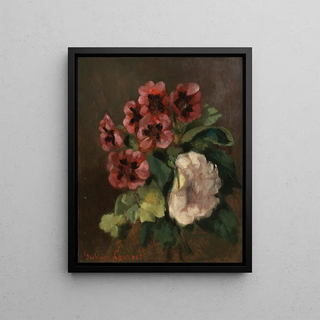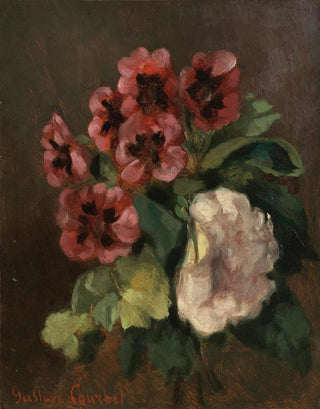Art print | Bouquet of flowers - Gustave Courbet


View from behind

Frame (optional)
Art print Bouquet of Flowers - Gustave Courbet – Captivating Introduction
The art print "Bouquet of Flowers" by Gustave Courbet is an iconic piece that embodies the richness and depth of the Realist movement. In this floral composition, Courbet manages to capture the very essence of nature, inviting the viewer to immerse themselves in a world of vibrant colors and delicate textures. This masterpiece, far more than a simple depiction of flowers, is a true ode to the ephemeral beauty of life. Through this art print, we have the opportunity to rediscover the magic of the original work, while appreciating the technical skill and artistic sensitivity of its creator.
Style and uniqueness of the work
Courbet's style is distinguished by his realistic approach, which diverges from the academic conventions of his time. In "Bouquet of Flowers," each petal, each leaf is rendered with meticulous care, demonstrating the artist's attentive observation. The colors, both vibrant and nuanced, create a harmonious contrast that draws the eye and evokes a sense of freshness. The composition, although seemingly simple, reveals an underlying complexity: the flowers appear almost alive, as if ready to bloom under the viewer's gaze. Courbet skillfully plays with light, creating delicate shadows that add depth to the work. It is this ability to combine realism and poetry that makes "Bouquet of Flowers" a masterpiece of the 19th century.
The artist and his influence
Gustave Courbet, born in 1819, is often regarded as the father of realism in painting. By challenging the established norms of the academy, he paved the way for many artists who sought to depict reality as it is, without embellishment or idealization. His approach, focused on everyday subjects and scenes of ordinary life, had a significant impact on the development of modern art. Courbet also influenced later movements, such as Impressionism, by encouraging artists to explore light and color in new ways. "Bouquet of Flowers" bears witness to this quest for truth and

Matte finish

View from behind

Frame (optional)
Art print Bouquet of Flowers - Gustave Courbet – Captivating Introduction
The art print "Bouquet of Flowers" by Gustave Courbet is an iconic piece that embodies the richness and depth of the Realist movement. In this floral composition, Courbet manages to capture the very essence of nature, inviting the viewer to immerse themselves in a world of vibrant colors and delicate textures. This masterpiece, far more than a simple depiction of flowers, is a true ode to the ephemeral beauty of life. Through this art print, we have the opportunity to rediscover the magic of the original work, while appreciating the technical skill and artistic sensitivity of its creator.
Style and uniqueness of the work
Courbet's style is distinguished by his realistic approach, which diverges from the academic conventions of his time. In "Bouquet of Flowers," each petal, each leaf is rendered with meticulous care, demonstrating the artist's attentive observation. The colors, both vibrant and nuanced, create a harmonious contrast that draws the eye and evokes a sense of freshness. The composition, although seemingly simple, reveals an underlying complexity: the flowers appear almost alive, as if ready to bloom under the viewer's gaze. Courbet skillfully plays with light, creating delicate shadows that add depth to the work. It is this ability to combine realism and poetry that makes "Bouquet of Flowers" a masterpiece of the 19th century.
The artist and his influence
Gustave Courbet, born in 1819, is often regarded as the father of realism in painting. By challenging the established norms of the academy, he paved the way for many artists who sought to depict reality as it is, without embellishment or idealization. His approach, focused on everyday subjects and scenes of ordinary life, had a significant impact on the development of modern art. Courbet also influenced later movements, such as Impressionism, by encouraging artists to explore light and color in new ways. "Bouquet of Flowers" bears witness to this quest for truth and






